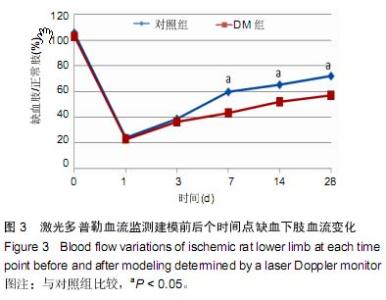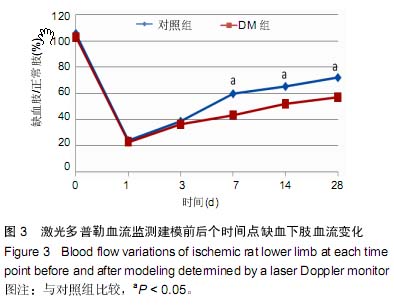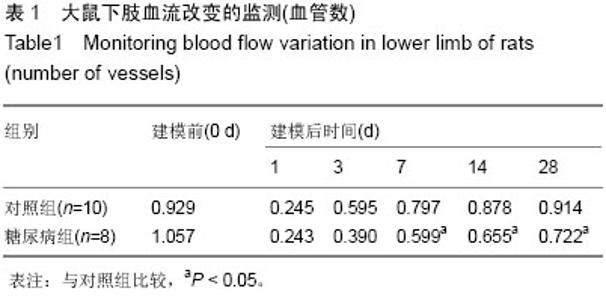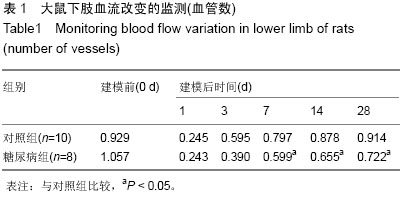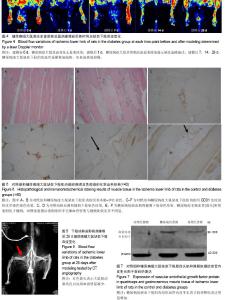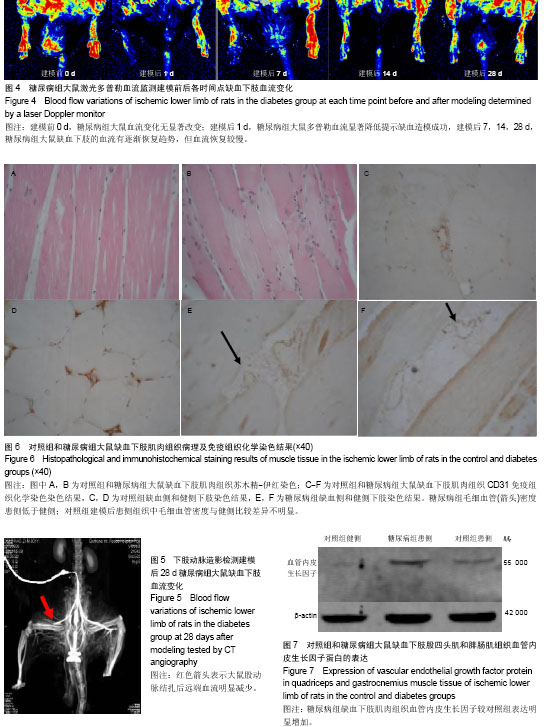| [1] Forsythe RO, Hinchliffe RJ. Management of peripheral arterial disease and the diabetic foot. J Cardiovasc Surg (Torino). 2014;55(2 Suppl 1):195-206.
[2] Brian P, Ari H, Yang YG, et al. eNOS affects both early and late collateral arterial adaptation and blood flow recovery after induction of hindlimb ischemia in mice. J Vasc Surg. 2010;51(1):165.
[3] Norgren L, Hiatt WR, Dormandy JA, et al. Inter-Society Consensus for the Management of Peripheral Arterial Disease (TASCII). Eur J Vasc Endovasc Surg. 2007;33(Suppl 1):S1-S75.
[4] Ozdemir BA, Brownrigg JR, Jones KG, et al. Systematic review of screening investigations for peripheral arterial disease in patients with diabetes mellitus. Surg Technol Int. 2013;23:51-58.
[5] Seguel G. An update on diabetic foot. Rev Med Chil. 2013; 141(11):1464-1469.
[6] Albayati MA, Shearman CP. Peripheral arterial disease and bypass surgery in the diabetic lower limb. Med Clin North Am. 2013;97(5):821-834.
[7] Smadja D, Silvestre JS, Levy BI. Genic and cellular therapy for peripheral arterial diseases. Transfus Clin Biol. 2013;20(2): 211-220.
[8] 李晓玲,朱旅云,宋光耀,等,脐带间充质干细胞移植治疗糖尿病下肢血管病变[J].中国组织工程研究,2014,(23):3670-3675.
[9] 谷涌泉,佟铸.干细胞移植促进血管新生的研究进展[J].中华细胞与干细胞杂志(电子版),2013,(2):56-60.
[10] 周晨光,宫经新,马跃,等,糖尿病对内皮祖细胞移植促血管新生作用的影响[J].中国组织工程研究,2013,(6):1044-1048.
[11] Limbourg A, Korff T, Napp LC, et al. Evaluation of postnatal arteriogenesis and angiogenesis in a mouse model of hind-limb ischemia. Nat Protoc. 2009;4(12):1737-1746.
[12] 蔡文杰,王铭洁,朱依纯,等.缺血模型中微循环功能研究方法的建立[J].中国药理学通报,2010,26(5):690-692.
[13] Peck MA, Crawford RS, Abularrage CJ, et al. A Functional Murine Model of Hindlimb Demand Ischemia. Ann Vasc Surg. 2010;24(4):532-537.
[14] 陈斌玲,焦雨欢,刘双,等.肢体缺血动物模型研究进展[J].中国医药导报,2012,9(1):12-14.
[15] Wang MJ, Cai WJ, Li N, et al. The hydrogen sulfide donor NaHS promotes angiogenesisin a rat model of hind limbischemia. Antioxid Redox Signal. 2010;12(9):1065-1077.
[16] 彭新桂,柏盈盈,居胜红.小鼠下肢急性缺血模型的制作及影像评价[J].东南大学学报(医学版),2014,(3):254-259.
[17] 覃明安,卢炳丰,黄蓉.CT灌注成像及CT动脉造影对下肢缺血模型侧支循环状况的检测分析[J].广西医科大学学报,2013,(6):
[18] Yang ZJ, Moritz WB, Nicolas D, et al. Call for a reference model of chronic hind limb ischemia toinvestigate therapeutic angiogenesis. Vasc Pharmacol. 2009;51(4):268-274.
[19] Dash SN, Dash NR, Guru B, et al. Towards reaching the target: clinical application of mesenchymal stem cells for diabetic foot ulcers. Rejuvenation Res. 2014;17(1):40-53.
[20] Yang M, Sheng L, Zhang TR, et al. Stem cell therapy for lower extremity diabetic ulcers: where do we stand. Biomed Res Int. 2013:462179.
[21] Tsuchimochi H, McCord JL, Hayes SG, et al. Chronic femoral artery occlusion augments exercise pressor reflex in decerebrated rats. Am J Physiol Heart Circ Physiol. 2010;299 (1): H106-H113.
[22] Westerweel PE, Rookmaaker MB, van Zonneveld AJ, et al. A study of neovascularization in the rat ischemic hindlimb using Araldite casting and Spalteholtz tissue clearing. Cardiovasc Pathol. 2005;14(6):294-297.
[23] Zhuo Y, Li SH, Chen MS, et al. Aging impairs the angiogenic response to ischemic injury and the activity of implanted cells: combined consequences for cell therapy in older recipients. J Thorac Cardiovasc Surg. 2010;139(5):1286-1294.
[24] 梁翠宏,田铧,徐蕴,等.结扎切断法与白芨微粒栓塞法建立大鼠后肢缺血模型效果比较[J].山东大学学报,2007,45(10):1008- 1010.
[25] Grigorios K, Wesley D. Gilson MS, et al. Hind limb ischemia in rabbitmodel: T2-prepared versus time-of-flight MR angiography at 3T. Radiology. 2007;245(3):761-763.
[26] 贾英斌,李坚,潘海燕.大鼠慢性肢体缺血模型的建立及其与急性肢体缺血模型的比较[J].中国普通外科杂志,2010,20(12) 1347-1350.
[27] Levigne D, Tobalem M, Modarressi A, et al. Hyperglycemia increases susceptibility to ischemic necrosis. Biomed Res Int. 2013:490964.
[28] Philippe F, Gianfranco M, Boussad S, et al. Coadministrationof Endothelial and Smooth Muscle Progenitor Cells Enhancesthe Efficiency of Proangiogenic Cel- l Based Therapy. Circ Res. 2008;103:751-760.
[29] Leong-Poi H, Kuliszewski MA, Lekas M, et al. Therapeutic arteriogenesis by ultrasound-mediated VEGF165 plasmid gene delivery to chronically ischemic skeletal muscle. Circ Res. 2007;101(3):295-303.
[30] Dai S, He Y, Zhang H, et al. Endothelial-specific expression of mitochondrial thioredoxin promotes ischemia-mediated arteriogenesis and angiogenesis. Arterioscler Thromb Vasc Biol. 2009,29(4):495-502.
[31] Erdem M, Bostan B, Gnes T, et al. Protective effects of melatonin on ischemia-reperfusion injury of skeletal muscle. Eklem Hastalik Cerrahisi. 2010;21(3):166-171.
[32] Capt HM, Hancock CGE, Lt-Cmdr AS, et al. Hemorrhagic shock worsens neuromuscular recovery in a porcine model of hind limb vascularinjury and ischemia reperfusion. J Vasc Surg. 2011;53(4):1052-1062. |
